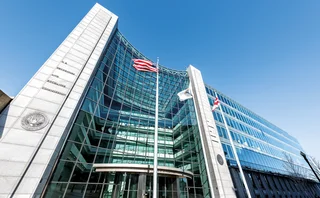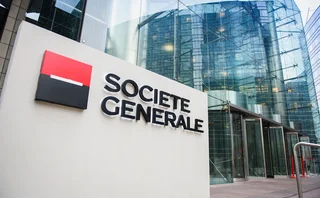
Eurex’s big US gamble
Eurex is taking its biggest gamble yet in going head-to-head with the Chicago Board of Trade. Some say it has stalled at the first hurdle. But Eurex US’s new chief, derivatives veteran Satish Nandapurkar, says he’s in it for the long haul.

From his twenty-fourth-floor office in America’s tallest building, the Sears Tower in Chicago, Satish Nandapurkar contemplates the home of the US futures exchange industry, a city that he, as the newly-appointed head of Eurex US, plans to stamp his mark on. “It’s a marathon,” he says, “and we’re in it for the long run.”
It’s just as well, for some people think the European derivatives exchange’s ambitious US operation, launched on February 8, has stalled just as it got started. “Have you looked at their volume figures?” a representative of the Chicago Board of Trade (CBOT) said gleefully after Risk contacted the exchange a few weeks after its rival Eurex US’s launch.
The CBOT official has a point. After an initial flurry of trading that saw almost 40,000 US Treasury futures contracts traded on the first day of operations, volumes have fallen away.
Tom Kloet, chief operating officer of Fimat, the international brokerage company owned by French bank Société Générale, has been observing the developments closely. As one of the world’s largest brokers, Fimat trades on all major derivatives exchanges. “Eurex faces a pretty big challenge to come in and be a major competitor,” he says. “When you come in and try to take a piece of the pie that’s currently in someone else’s market, then you need to either bring value or lower prices significantly. Eurex did lower prices significantly, but the incumbent matched it. The fact that the CBOT was reactionary to the competitive situation was significant.”
He is referring to the CBOT’s move immediately before the launch of Eurex US to reduce transaction fees for all customers electronically trading its US Treasury futures and options on futures. For six months – with a further review by the CBOT’s board to come after that – CBOT’s board agreed that fees for members trading for a member-owned account on an individual or firm-owned seat are to be waived.
Usually, users pay 10 cents per side for the first 250,000 contracts traded and 5 cents per side thereafter. At the same time, the board agreed that non-members trading for an individual member’s, or member firm’s, proprietary account will pay a flat fee of 6 cents per side. Previously, they paid 30 cents per side for the first 100,000 contracts traded and 20 cents per side thereafter.
Non-members, meanwhile, are now paying a flat fee of 30 cents for futures trades and 50 cents for options; before, they paid 90 cents for the first 100,000 contracts traded and 75 cents thereafter.
But Nandapurkar is quick to defend his fledgling business. His first goal, he says, was for a timely and smooth launch following approval by the Commodity Futures Trading Commission (CFTC).
That first goal has been achieved. “Our liquidity is the best ever on a new exchange,” says Nandapurkar. “In the first month of trading, we have already been seeing equal or better price quality for 75% of the time. And there has been steady growth in open interest.”
Offerings
Eurex US currently offers customers futures and options on futures on two-, five- and 10-year Treasury notes, and 30-year Treasury bonds. It has also announced its entry into the equity index options market (see New Angles, page 12). When the details of Eurex US were announced in September last year, Eurex committed itself to price levels that would not exceed 30 cents per contract and a five-year pricing programme – actual fees at launch were a maximum of 25 cents per contract.
“We have a five-year commitment to sustaining low fees, and we offer these fees to all customers across all product groups,” says Nandapurkar. “This is not currently reflected in the pricing structure of the majority of US benchmark contracts other than those we are trading, and this is where we see our value proposition in terms of fees.”
But it seems clear that the CBOT is more than willing to aggressively face up to whatever Eurex throws at it in terms of price competition, and is becoming increasingly vocal about this. Speaking at a conference at the end of February, the CBOT’s chief executive, Bernie Dan, told delegates at a conference in Florida that although his business is “facing competition out of Germany… we have seen little, if any, impact”.
He added: “The CBOT offers highly competitive transaction fees and provides a trading environment with attributes unavailable elsewhere… Those attributes give the CBOT the edge over competition and will allow the CBOT to overcome challenges from those who mistakenly believe they can win liquidity simply by slashing prices or catering a market model to a few select users.”
And as if to make the point absolutely clear that it is prepared to take the fight to Eurex, the CBOT even announced at the beginning of February that, subject to CFTC approval, it will launch electronic trading of German debt futures contracts, the Bund, the Bobl and the Schatz.
The CBOT says the products are a natural extension of its current fixed-income offerings, but the move was seen by the industry as a political one designed to show Eurex that if it was prepared to step into the CBOT’s space, then the CBOT was equally willing to step into the European exchange’s markets.
It’s all a far cry from the days when the CBOT and Eurex worked together on the a/c/e (alliance/CBOT/Eurex) trading platform. The relationship broke down in July 2002 amid allegations by Eurex that the CBOT was not committed to financing the development costs of the e-platform. The CBOT then looked for another technology provider and turned to the London International Financial Futures and Options Exchange’s (Liffe) Liffe.Connect system.
The CBOT’s switch to Liffe.Connect, despite effectively taking place by default due to the breakdown of a/c/e, has played a crucial element in its competitive position with Eurex US. The transition, which completed at the beginning of January, has by all accounts been well received by those trading on the CBOT, and it has been credited with increasing volumes. “It is evident that the trading system [Liffe.Connect] that the CBOT has is clearly meeting customer expectations,” says Fimat’s Kloet.
But Eurex’s platform has also proved itself in Europe. “Our trading platform is clearly a benchmark for the industry,” says Nandapurkar. So if both exchanges are roughly on an equal footing when it comes to trading costs and platforms, where else can Eurex try to make a difference? One area is on the clearing side.
Eurex US is waiting to get approval from the CFTC for a clearing link that it wants to establish between its European operations and the Clearing Corporation, its US clearing system. If Eurex US can’t beat the CBOT when it comes to transaction fees or the trading system, the benefits of netting across a vast number of products could be the way to go.
“The clearing link will provide tremendous value,” says Nandapurkar. “With its introduction and the subsequent listing of our euro-denominated products, customers will have US Treasury products, European fixed-income and equity index products on the same platform and in one clearing house. They will benefit from margin offsets and will be able to use their collateral more efficiently.
“Customers will have the ability to trade and clear where it is most efficient for them – be it locally or globally. This has significant implications for customers who are, for example, limited to buying US products through US exchanges and clearing houses. Those are the things that will bring more users to the market-place.”
Nandapurkar knows he faces big challenges, but he is quietly optimistic that in the long run Eurex US will succeed. “Over time, with additional customers and products, and with the launch of the clearing link, we will see volumes pick up,” he says.
Now look at the Chicago futures industry five years from now. If Nandapurkar and his ambitious boss, Eurex’s chief executive Rudolph Ferscha, get their way, then the Chicago futures industry will look very different. But it will always be a question of volumes. “It’s a long-run game and we’re only in the early part,” says Kloet. “I don’t think I have a firm view yet on whether Eurex US will still be around in five years. But if they don’t innovate then they won’t be.”
All roads lead to Chicago
Satish Nandapurkar presented himself to Rudolph Ferscha, Eurex’s chief executive, with an impressive CV for the job of head of Eurex US. After a stint in the US Air Force after college – he signed up to get his Massachusetts Institute of Technology tuition fees paid for, and in return had to commit himself to serve four years after graduation – he was instrumental in establishing the structured products business at Swiss Bank Corporation (SBC), before various moves took him gradually towards the derivatives exchange industry.
“If someone had said to me five years ago that I would be running an exchange now, I would never have believed them,” he says.
When he left the air force in 1988, Nandapurkar’s first job was as a trainee trader on the Philadelphia Stock Exchange’s trading floor, with trading firm O’Connor. “At that time, the direction I wanted to take was the trading of derivatives, and options especially. Options were a little bit more quantitative, a little bit more technical.”
It was in late 1988, when he was training in Chicago, that Nandapurkar met the man that would help shape his career over the coming decade-and-a-half – Jim McNulty, then also with O’Connor, but later chief executive of the Chicago Mercantile Exchange (CME).
It was also in the late 1980s that O’Connor was starting a relationship with SBC that would ultimately lead to a full takeover by the Swiss giant in the 1990s. “O’Connor was changing from being a local trading firm to being a firm that was partnered with a much larger bank. The company was very good on the trading side, but we needed to start thinking about the marketing and structuring side, and this was something Jim McNulty was very involved with.”
McNulty grabbed Nandapurkar in late 1989 and asked him to start working on the marketing and structuring of derivatives products. “My job was to go out on the road, see what customers wanted, help structure that product and figure out how to break its risks into more standard risks that could be managed in the various trading books we had. And I had to figure out how to manage the residual risk.”
In 1993, Nandapurkar was asked to move into foreign exchange and run the exotic options business. “The exotics business on the forex side really turned into barriers, and at Swiss Bank we were probably one of the first to commoditise the barrier options business, from about 1993 to 1995,” says Nandapurkar. “We created practical skew-based models, and I think we had the first model that didn’t require the highly quantitative guy looking at things from three different ways before giving you a price. So you could push the model out to sales people.”
He moved to London in 1994 but then left SBC in 1996 to return to the US, this time in New York to work for Deutsche Bank, setting up its equity derivatives business. But he kept this role for just 18 months. Starting a business from scratch proved too slow for Deutsche and it decided to buy NatWest’s entire equity derivatives trading outfit. The result was that there wasn’t much room for Nandapurkar, with his own growth strategies.
And so it was back to building a foreign exchange derivatives business, this time at Bank of America. “Bank of America was a strong player on the spot and forwards side, but not a very strong player on the options side, so the challenge was to make them more of a global options business and much more customer-focused.”
He was about six months into building this business when the merger with NationsBank was announced. The focus at Bank of America then, says Nandapurkar, switched from developing businesses to making sure the merger worked. NationsBank’s forex business was based in Chicago, where Nandapurkar moved.
Next the dotcom bug bit, and Nandapurkar tried his luck at a company called Optimark, which was attempting to create an electronic exchange for block trading. It failed. The system, it seemed, was strong on the technology side but never quite managed to solve the problem of how people like to interact when trading.
It was at this point that McNulty came back into the picture. Taking over as chief executive of the CME, he asked Nandapurkar to work for him again. Initially this meant trying to start a business-to-business e-commerce effort. But when that market fell away in 2001, Nandapurkar found himself being promoted to head of sales, marketing and product development for all the CME’s products, and in charge of a staff of 120.
With such a strong technical and business background, it is no surprise that Ferscha came calling when he needed an all-rounder to build him an exchange. Nandapurkar says: “My skill set has always been sitting in between the four pillars of trading, sales, technology and quantitative research.”
|
Only users who have a paid subscription or are part of a corporate subscription are able to print or copy content.
To access these options, along with all other subscription benefits, please contact info@risk.net or view our subscription options here: http://subscriptions.risk.net/subscribe
You are currently unable to print this content. Please contact info@risk.net to find out more.
You are currently unable to copy this content. Please contact info@risk.net to find out more.
Copyright Infopro Digital Limited. All rights reserved.
As outlined in our terms and conditions, https://www.infopro-digital.com/terms-and-conditions/subscriptions/ (point 2.4), printing is limited to a single copy.
If you would like to purchase additional rights please email info@risk.net
Copyright Infopro Digital Limited. All rights reserved.
You may share this content using our article tools. As outlined in our terms and conditions, https://www.infopro-digital.com/terms-and-conditions/subscriptions/ (clause 2.4), an Authorised User may only make one copy of the materials for their own personal use. You must also comply with the restrictions in clause 2.5.
If you would like to purchase additional rights please email info@risk.net
More on People
Calpers adds machine learning specialist Simonian
Champion of using AI and game theory in investing risk management joins US public fund
People: All shook up at the SEC, Krens succeeds Litvack at Isda, and more
Latest job changes across the industry
Girolami to leave LCH for NatWest
Clearing house CEO named CIB head for UK lender
People: SocGen and Nomura spot slew of FX hires, RepoClear gets new head, and more
Latest job changes across the industry
People: All fall in at Citi, TD turbulence, and more
Latest job changes across the industry
Asia moves: senior hires at Citi, BNP Paribas, and more
Latest job news from across the industry
People: Masters moves into FNZ, Two Sigma founders step back, and more
Latest job changes across the industry
Cardano’s Max Verheijen moves to BasisPoint
Verheijen spent 24 years at the Dutch pension advisory firm







